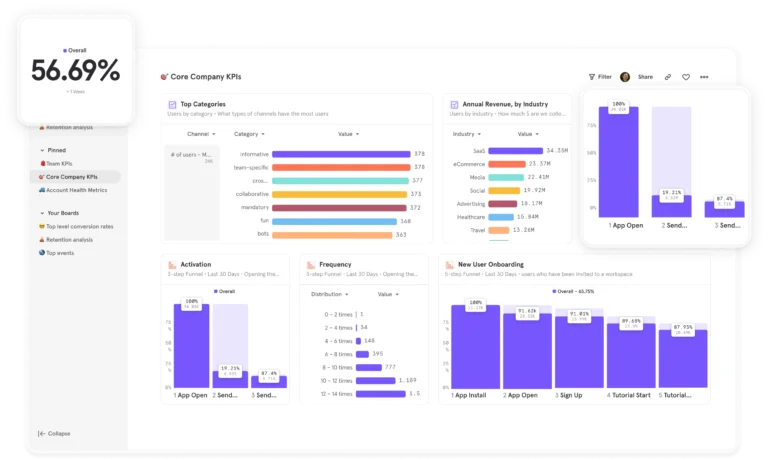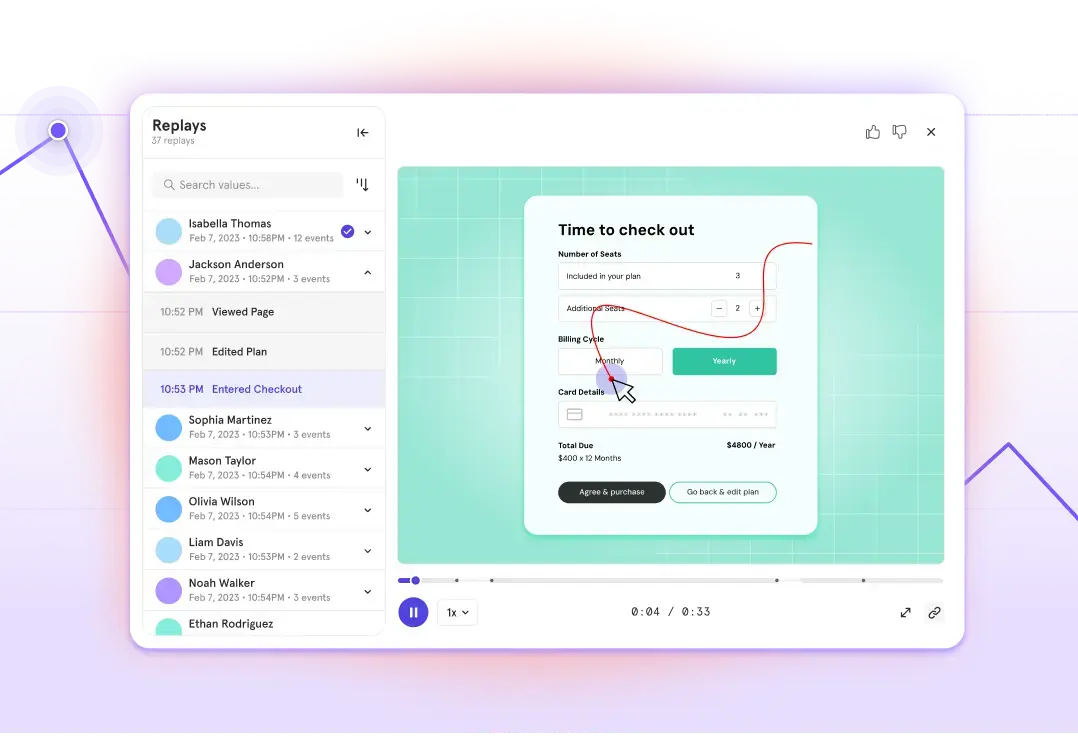
Enterprise analytics explained: Breaking down silos and scaling insights

Enterprise analytics is the tools and processes large companies use to gather and analyze company data. Companies with robust enterprise analytics use that data to drive decision-making. Enterprise analytics solutions need to scale, analyze large amounts of data, and have the functionality to support a wide variety of use cases for different teams across the company.
Every company aims to grow, but even the largest and most successful companies experience some bumps along the way.
And many of those challenges don’t go away once companies have hundreds of employees—if anything, problems like teams working in silos, inefficient processes, or a change-resistant company culture become magnified at larger companies and enterprises (usually defined as companies with annual revenue over $50 million and at least 500 employees, although definitions vary).
But enterprise-level companies also have more resources and opportunities to build successful systems that work for their entire organization, including enterprise analytics. With the right platforms and processes in place, large companies can harness their bountiful and valuable data and keep teams aligned.
Let’s talk about what enterprise analytics is, how it differs from analytics at smaller companies, plus some of the benefits and challenges.
What is enterprise analytics?
Enterprise analytics is the tools and processes large companies use to gather and analyze company data. Companies with robust enterprise analytics use that data to drive decision-making. Enterprise analytics solutions need to scale, analyze large amounts of data, and have the functionality to support a wide variety of use cases for different teams across the company.
Enterprises generate so much data that they often have more than they know what to do with, even with dedicated data teams in place. Unlike startups (and to a lesser extent mid-market-sized companies), where team members often wear several hats and take on projects outside the scope of their role, both job functions and data can be easily siloed at the enterprise level.
Large companies need to actively work to build a data-driven culture of collaboration and create opportunities for teams to work together. To support that, they need enterprise analytics tools that can span teams and functions within companies to avoid data siloes and support self-serve analysis.
Enterprise analytics need features that keep everyone aligned on business goals. For example, dashboards can give everyone insights into the same key metrics in a single place, and data governance tools keep data clean, organized, and clearly labeled, so everyone is working with the same information.

In the same vein, many enterprise analytics solutions connect to data warehouses, which can serve as single sources of truth for revenue, CRM, ad spending, and product data. This ensures that everyone stays aligned, even across large companies with widespread teams.
Enterprise analytics in practice: Arming cross-functional teams with data
Personal finance management company Quicken needed an analytics solution that could support many different teams with reliable data and self-serve functionality, to help teams work in concert towards common goals.
Quicken switched from Adobe Analytics (Omniture) to Mixpanel so that everyone in the company had better access reporting and custom dashboards to find actionable insights. That knowledge enabled them to provide customers with a seamless user experience. Having all of their insights in one place improved collaboration and helped Quicken break down silos.
Now, data and analysis from Mixpanel is used across functional areas, from weekly finance and business reviews to behavior tracking, product testing, and API monitoring. Quicken engineering teams use Mixpanel to help surface and fix errors in the product. Marketing relies on Mixpanel funnel analysis to identify drop-off points in the purchase process. All Quicken teams are working from the same source of truth.
Benefits of enterprise analytics
Powerful enterprise analytics offer many advantages: they can break down silos across departments and promote collaboration. If everyone is working with the same data from the same data source, teams can reach a consensus and focus on the same priorities, even when they have different KPIs.
Centralized insights can also improve operational efficiency. Enterprise companies typically have more complex tech stacks, and it’s smoother to streamline processes and eliminate unnecessary tools when you’re all using the same source of truth and can trust the data you’re seeing.
Advanced behavioral analytics are the key to enhancing customer experiences. With both qualitative and quantitative user data at their disposal, enterprises can measure the impact of features they ship and build their roadmap based on that feedback. They can deepen their understanding of the customer journey, and identify roadblocks and opportunities at scale.
We asked scale-up and enterprise leaders how they use product analytics to grow their companies. Here’s what they told us.
Enterprise analytics in practice: Understanding users at scale
HR software company Employment Hero helps more than 300,000 businesses worldwide, with over 2 million active users of the platform. The company needs both quantitative and qualitative data to understand customers and make data-driven decisions to stay ahead of the competition.
But with hundreds of thousands of customers, gathering qualitative data is easier said than done: Customer interviews and surveys are time-consuming and difficult to organize. Even with hours of effort and outreach, you might still only speak to 10 or 20 customers, which is hardly a representative sample of the company’s overall user base. Employment Hero decided to use Mixpanel Session Replay to gather large amounts of qualitative insights faster. Now the team can use a single tool to see both qualitative and quantitative data in a single place, eliminating 8+ hours of manual user journey data consolidation for each release.
Challenges of enterprise analytics
Setting up and managing enterprise analytics presents several challenges. For companies just getting started, there are basically two options, as Glenn Vanderlinden, Co-Founder and Strategy Lead at Human37, explains: You can create a team to manage analytics, or you can adapt your processes. Adapting your processes is usually the more popular choice since it’s less disruptive than creating a new team. Both options require accountability and a clear structure for ownership of processes.
Enterprise companies need to manage the complexity of large data sets from multiple sources, which can create discrepancies or redundancies in your analytics if they aren’t integrated properly. And since they tend to work with more demanding and security-conscious clients, maintaining compliance with security and data protection standards like SOC 2 and GDPR are a must.
On top of that, sizable organization can be older with more ingrained cultural challenges to overcome and resistance to change. It can be difficult to get large, distributed teams to adopt new tools. But on the other hand, the cost and resources of maintaining legacy systems make it impossible to not update software regularly.
Enterprise analytics in practice: Integrating with a sophisticated tech stack to deliver insights
Review platform Yelp needed a product analytics tool that would integrate seamlessly with business intelligence (BI) and the rest of its enterprise tech stack. The team chose Mixpanel for its easy implementation and smooth integration, which allowed them to start gathering insights quickly. With Mixpanel, Yelp has decreased the time between ideation and launch for critical features and reduced the time required to conduct product analysis from weeks to a few days.
How to implement enterprise analytics
Implementing and onboarding analytics platforms presents unique challenges for enterprise companies that smaller businesses don’t face. More stakeholders and greater bureaucracy can slow down decision-making. Here are a few steps to get started:
Define analytics goals across departments
Work with different departments like marketing, product, and operations to understand each team’s needs and choose a solution that meets their different requirements. Using too many different analytics tools for different departments can cause data silos and discrepancies down the line.
Build a tech stack that integrates with enterprise systems
Large companies need a tech stack that will support their size and be able to handle vast amounts of data at scale. That means using a CRM built for enterprise and a data warehouse that can store and organize large amounts of data automatically.
Create a scalable framework for measuring KPIs and visualizing data
Enterprises need to measure and visualize data in a way that can incorporate more metrics and more data as requirements expand. One way to think strategically about data tracking is to create a tracking plan and build a scalable schema to support it.
Buy vs. build your own analytics
Some companies with resources may weigh the option to build their own enterprise analytics solutions, but in-house solutions often take up engineering resources that are needed elsewhere.
How to choose the right enterprise analytics software
When choosing an enterprise analytics solution, it’s important to prioritize key capabilities. Any platform you choose should be able to scale to handle large data volumes for multiple teams. It should have powerful governance tools to maintain data integrity and meet compliance requirements.
Powerful enterprise analytics software also serves real-time insights without engineering or data analysts’ support, so that any non-technical team across the company can analyze data without creating bottlenecks.


